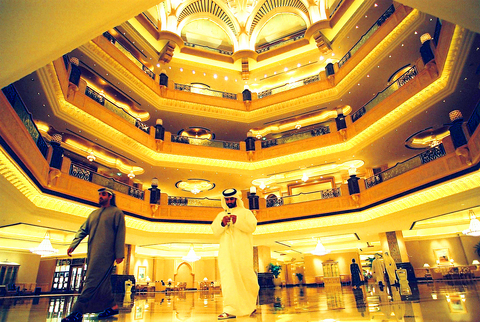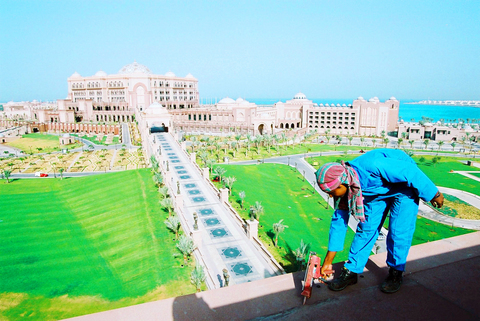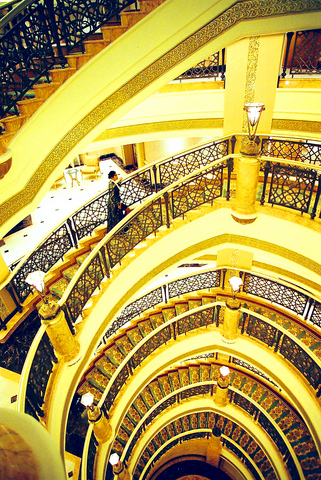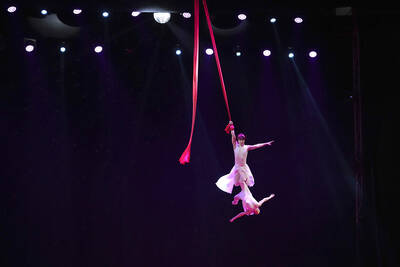At roughly US$3 billion, the Emirates Palace in Abu Dhabi, which just opened to the public, is said to be the most expensive hotel ever built. A billion won't buy what it used to, of course, but three seems to do just fine.
Although it has fewer than 400 rooms, the hotel features 128 kitchens and pantries, 1,002 custom-made Swarovski crystal chandeliers (requiring a full-time staff of 10 just to keep them clean) and what Willy Optekamp, the hotel's general manager, says is the world's largest dome over the lobby.
"Think about coffee," he said, and obviously he has. "We serve coffee on a silver tray with rose petals, crystallized sugar, a linen napkin, marzipan croissants, a bottle of imported water and the coffee. The ladies get a rose."

PHOTO: NY TIMES
The hotel is built of an immense amount of imported marble and hasplans for 20 restaurants and a layout so sprawling -- 60 acres of interior space -- that the staff will soon be equipped with golf carts to navigate the corridors. "Some of them are over a kilometer long," Optekamp said. "If a maid goes to lunch, she may never make it back."
While war and civil unrest make headlines elsewhere in the Middle East, a number of small countries rich in oil remain peaceful places primarily consumed with disposing of their enormous surplus of cash, which has multiplied with the rapid increase in world oil prices. The Emirates Palace, owned by the government of Abu Dhabi, is perhaps the ultimate case in point.
The US$3 billion price tag is actually an estimate. But a few hundred million is a rounding error for this tiny emirate: With 92 billion barrels in proven reserves, every time the price of a barrel of oil rises by a dollar, as it has in the last few days, Abu Dhabi could build 30 more of these hotels.

During turndown service, the staff puts a sachet of lavender between the sheets to perfume them. When they are done they tuck the lavender under the pillows so the fresh scent will waft over the guest at night. The hotel, managed by upscale German hotelier Kempinski Hotels and Resorts, has bath butlers standing by to prepare one of seven baths listed on the bath menu. If you are prepared to go off menu, you can get your tub filled with champagne for a few thousand dollars.
Pool and beach service includes roving staff members to clean sunglasses, cooling guests with soothing sprays of water and supply fruit sticks. Near the long private beach, over 1km, two pools meander for the length of several football fields, interspersed with Jacuzzis.
Rooms, which range from an almost embarrassingly modest US$625 a night to US$13,000 (subject to a 20 percent service charge), come with floors of inlaid marble and soft carpeting. Recessed ceiling lighting almost imperceptibly illuminates a muted color scheme that is said to be inspired by the desert sands outside.

PHOTO: NY TIMES
As with any new enterprise, there are still a few kinks to work out. Connecting doors between many of the suites are not soundproof, leading some early guests to complain about overhearing the neighbors. Staff members still get lost in the maze of hallways, and everyone is looking forward to the delivery of the golf carts, 45 in all.
The chief architect, John Elliott of Wimberly Allison Tong and Goo, a London architectural firm, has considerable experience designing palaces, having done one for the Sultan of Brunei. Since the Emirates Palace was first envisioned as a place where government conferences would be held and only later was expanded into a hotel, Elliott feels that describing it as the world's most expensive hotel is inappropriate. "Everybody would be stunned if you said that Buckingham Palace wasn't cost effective," he said.
Six rulers' suites on the top floor of the hotel are to be used only by royalty visiting from other Persian Gulf countries. A special Arc de Triomphe style entrance is reserved for their
motorcades.
Guests are still something of a novelty. In fact, with the hotel only beginning to take reservations, almost all of the people in the lobby are employees. Even when the place is full, staff members will outnumber guests by six to one.
A day after the official opening, Ronald Schroeter sat in the lobby cafe, looking stunned. "It's a little crazy, isn't it?" he said, looking for support to his girlfriend. Visiting from Germany on vacation, the two had come to have coffee and a look around. Schroeter, the owner of a sports store, admitted that he had not even bothered to ask about prices. "This is for kings," he said, gazing at the golden ceiling arches.
Rather than the last word in luxury accommodations, however, the Emirates Palace may just be the start of the discussion. Elliott says he is already in secretive talks with several sheiks in the region. "Other rulers have seen the palace," he says, "and they like what they've seen."

The canonical shot of an East Asian city is a night skyline studded with towering apartment and office buildings, bright with neon and plastic signage, a landscape of energy and modernity. Another classic image is the same city seen from above, in which identical apartment towers march across the city, spilling out over nearby geography, like stylized soldiers colonizing new territory in a board game. Densely populated dynamic conurbations of money, technological innovation and convenience, it is hard to see the cities of East Asia as what they truly are: necropolises. Why is this? The East Asian development model, with

Desperate dads meet in car parks to exchange packets; exhausted parents slip it into their kids’ drinks; families wait months for prescriptions buy it “off label.” But is it worth the risk? “The first time I gave him a gummy, I thought, ‘Oh my God, have I killed him?’ He just passed out in front of the TV. That never happens.” Jen remembers giving her son, David, six, melatonin to help him sleep. She got them from a friend, a pediatrician who gave them to her own child. “It was sort of hilarious. She had half a tub of gummies,

The wide-screen spectacle of Formula One gets a gleaming, rip-roaring workout in Joseph Kosinski’s F1, a fine-tuned machine of a movie that, in its most riveting racing scenes, approaches a kind of high-speed splendor. Kosinski, who last endeavored to put moviegoers in the seat of a fighter jet in Top Gun: Maverick, has moved to the open cockpits of Formula One with much the same affection, if not outright need, for speed. A lot of the same team is back. Jerry Bruckheimer produces. Ehren Kruger, a co-writer on Maverick, takes sole credit here. Hans Zimmer, a co-composer previously, supplies the thumping

No more elephant and monkey acts. No more death-defying motorbike stunts. No more singing or acting on stage. Several hundred spectators still clapped constantly when acrobats with Dongchoon Circus Troupe, South Korea’s last and 100-year-old circus, twirled on a long suspended fabric, juggled clubs on a large, rotating wheel and rode a unicycle on a tightrope under the big top. “As I recall the hardship that I’ve gone through, I think I’ve done something significant,” Park Sae-hwan, the head of the circus, said in a recent interview. “But I also feel heavy responsibility because if Dongchoon stops, our country’s circus, one genre